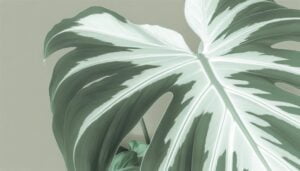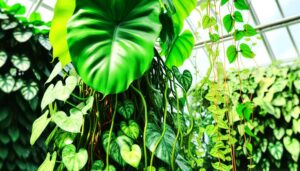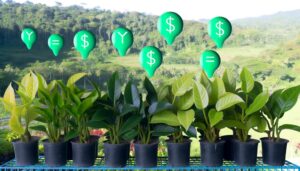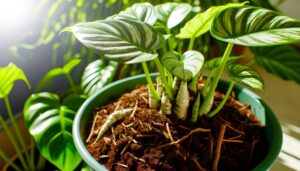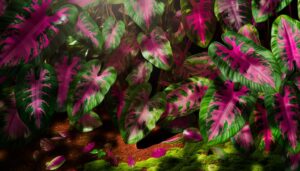What Does a Mature Philodendron Verrucosum Look Like?
A mature Philodendron verrucosum exhibits large, heart-shaped leaves measuring up to 45 cm in length and 30 cm in width. The leaves showcase a vivid blend of deep green, maroon, and iridescent blue hues, with a velvety surface and pronounced reticulate venation.
Stems reach up to 2 cm in diameter and 50 cm in length, adorned with fine trichomes and ridges. The plant's climbing habit enables it to achieve heights of up to 3 meters, supported by aerial roots up to 20 cm in length.
For a thorough understanding of its unique characteristics, continue exploring the intricate details.
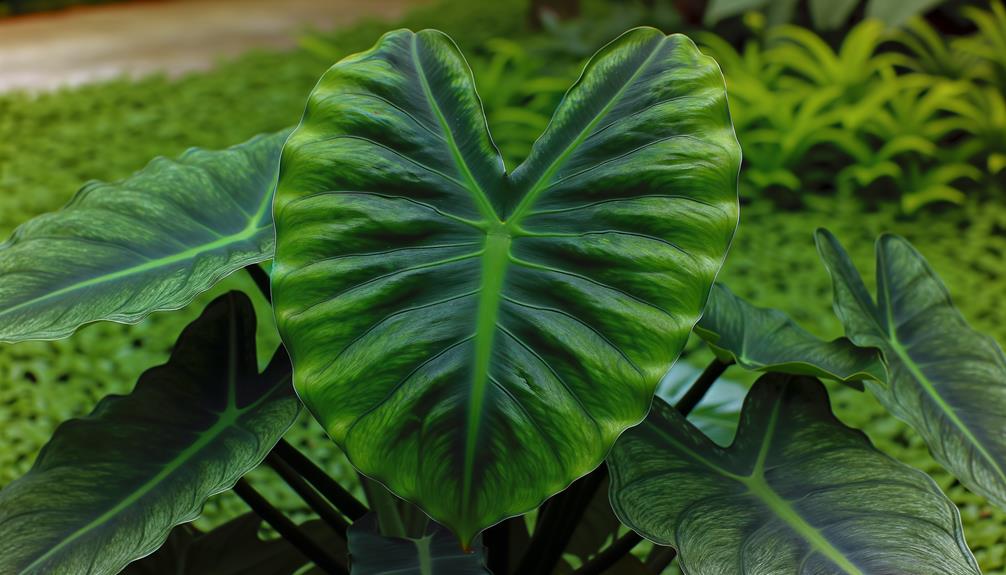
Key Takeaways
- Large, heart-shaped leaves with vivid deep green, maroon, and iridescent blue tones.
- Velvety-textured stems ranging from deep green to reddish-brown, supporting a climbing habit.
- Pronounced venation pattern with highlighted primary veins and a reticulate pattern.
- Aerial and subterranean roots aiding in stability and nutrient uptake.
- Height ranging from 3 to 6 feet with expansive foliage and petioles up to 18 inches in length.
Leaf Size and Shape
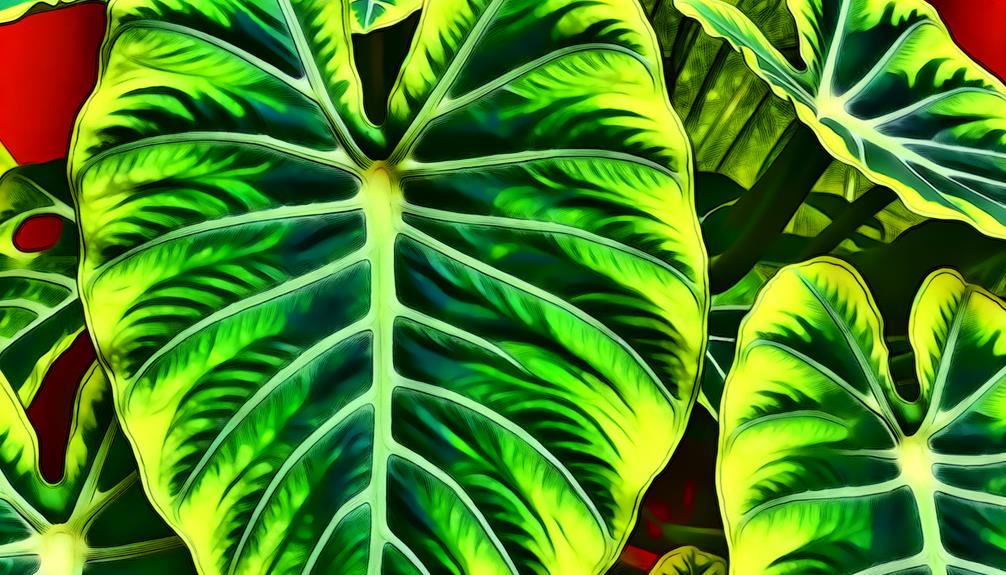
The mature Philodendron verrucosum is characterized by its large, heart-shaped leaves, which can reach up to 45 centimeters in length and 30 centimeters in width, displaying a pronounced venation pattern. These expansive leaves exhibit a cordate morphology, with a notable sinus at the base where the lobes diverge.
The leaf blades are typically smooth, with distinct, elevated veins that provide structural integrity and facilitate efficient nutrient transport. Petioles, often exceeding 30 centimeters in length, support the substantial foliage. The leaf margins are entire, lacking serration, which contributes to a streamlined appearance.
Additionally, the adaxial (upper) surface of the leaves is generally more textured than the abaxial (lower) surface, enhancing the leaf's photosynthetic efficiency and overall physiological function.
Coloration and Patterns
Exhibiting a stunning array of hues, mature Philodendron verrucosum leaves typically showcase a vivid combination of deep green, maroon, and even iridescent blue tones, with intricate patterns that accentuate the prominent venation. The leaves measure approximately 20-30 cm in length and 15-20 cm in width, displaying a reticulate venation pattern where the primary veins are often highlighted in shades of cream or light green.
The coloration may vary depending on light exposure and environmental conditions, with lower light intensifying the maroon hues. The iridescent blue tones are generally seen under certain light angles, adding a unique visual dimension. These pigments are a result of complex anthocyanin and chlorophyll interactions, contributing to the plant's striking appearance.
Leaf Texture
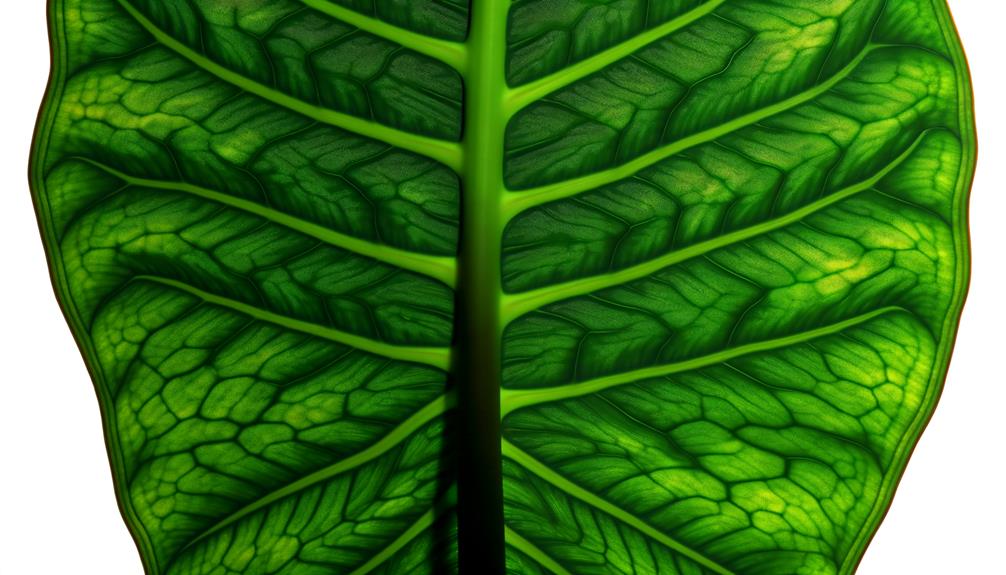
Characterized by a velvety surface, the mature Philodendron verrucosum leaves possess a tactile quality that is both soft and slightly fuzzy to the touch. This unique texture arises from the presence of fine trichomes that densely cover the leaf's surface.
These trichomes not only contribute to the plant's aesthetic appeal but also play a role in reducing water loss and deterring herbivory. Each leaf typically spans 20-30 centimeters in length and 15-25 centimeters in width. The leaf's upper epidermis is adorned with these microscopic hair-like structures, creating a sensation akin to velvet.
The fine texture of the leaves, coupled with their striking visual patterns, enhances the overall allure of the mature Philodendron verrucosum in botanical collections.
Stem Characteristics
The stems of Philodendron verrucosum exhibit a distinctive, velvety texture characterized by fine trichomes and a slightly ridged surface.
Typically, the coloration ranges from deep green to reddish-brown, often interspersed with irregular patterns.
Mature stems can achieve a diameter of up to 2 cm and may extend to lengths exceeding 50 cm, supporting the plant's climbing habit.
Texture and Appearance
Philodendron verrucosum stems exhibit a notable texture, characterized by their velvety, hair-like trichomes that provide a distinct tactile experience. These trichomes, approximately 0.2 to 0.5 millimeters in length, serve not only as a protective mechanism but also enhance the plant's aesthetic appeal.
Upon close inspection, one can observe:
- Fine, dense trichomes that create a soft, almost fuzzy outer layer.
- Subtle ridges and grooves along the stem, contributing to its unique texture.
- Minute nodal structures where the petioles attach, often accentuated by the trichomes.
The combination of these features makes the Philodendron verrucosum's stem visually and texturally distinctive, appealing to both botanists and horticultural enthusiasts. This textural complexity underscores the plant's evolutionary adaptations for survival and reproduction.
Color and Patterns
Beyond its unique texture, the stem of Philodendron verrucosum also exhibits a remarkable array of colors and patterns, ranging from deep green to reddish hues, often intermixed with fine, lighter streaks that follow the stem's longitudinal ridges. These chromatic variations are not merely ornamental; they serve functional roles in photosynthesis and protection. Each stem segment measures approximately 5-10 mm in diameter, with the color intensity varying based on light exposure and maturation stage. The table below captures the visual and structural nuances:
| Characteristic | Observation |
|---|---|
| Primary Color | Deep green to reddish hues |
| Pattern Details | Light streaks along longitudinal ridges |
| Stem Diameter | Approximately 5-10 mm |
This complex coloration and patterning underscore the plant's adaptability and aesthetic appeal.
Growth and Size
Characterized by sturdy and elongated stems, Philodendron verrucosum exhibits significant growth variations influenced by environmental conditions, typically achieving lengths between 30 to 50 cm. The stems are visually striking with a unique combination of textures and colors.
Noteworthy observations include:
- Surface Texture: Stems feature prominent, velvety verrucose (wart-like) projections, enhancing tactile and visual interest.
- Coloration: Stems display a gradient of green hues, often with a subtle reddish or purplish tint, especially near nodes.
- Structural Integrity: Despite their delicate appearance, the stems provide substantial support for the expansive foliage.
These characteristics not only contribute to the plant's aesthetic appeal but also play a significant role in its physiological functions, such as nutrient transport and structural stability. This makes the Philodendron verrucosum a captivating subject for both botanical enthusiasts and professionals.
Growth Habit
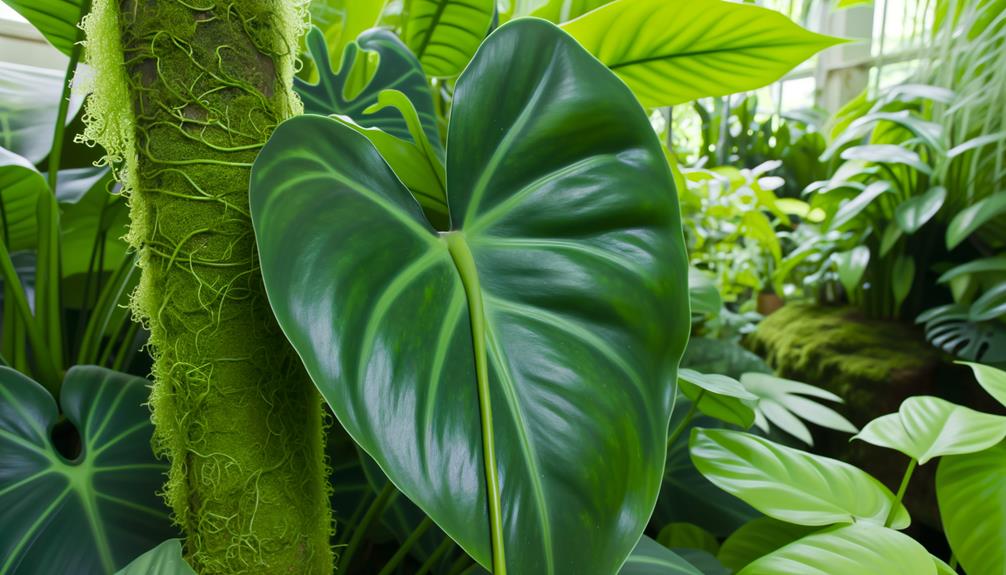
Exhibiting a climbing growth habit, the mature Philodendron verrucosum can reach heights of up to 3 meters when provided with adequate support structures, such as a moss pole or trellis.
This species demonstrates a vining nature, characterized by elongated internodes and robust, heart-shaped leaves measuring approximately 30-45 cm in length. The plant's petioles are covered in small, bristle-like structures, contributing to its distinctive appearance.
The stems exhibit a semi-woody texture, facilitating its ability to latch onto support surfaces. When climbing, the Philodendron verrucosum leverages aerial roots to anchor itself, optimizing vertical growth.
This natural inclination for upward expansion allows it to maximize light exposure, a crucial factor for photosynthesis and overall plant well-being.
Root System
The root system of the mature Philodendron verrucosum exhibits both aerial and subterranean root structures.
Characterized by their robust and fibrous nature, these roots serve distinct functions within the plant's ecosystem. Aerial roots, which can reach lengths of up to 20 cm, facilitate attachment and nutrient absorption from the surrounding environment.
On the other hand, subterranean roots, typically extending to depths of 15-30 cm, possess a high density of root hairs, enhancing water and nutrient uptake efficiency.
Root Structure Characteristics
Philodendron verrucosum displays a fibrous root system that is both extensive and highly effective in nutrient absorption, characterized by numerous fine root hairs that increase surface area. This intricate network plays a crucial role in supporting the plant's vigorous growth.
Significantly, the root structure features:
- Adventitious roots: These emerge from the stem, improving the plant's stability and nutrient uptake.
- Root hairs: Tiny extensions that significantly increase the absorptive surface area, aiding in efficient water and nutrient intake.
- Secondary roots: Branching off from primary roots, these play a key role in a widespread distribution within the soil, optimizing access to resources.
The fibrous nature of the root system guarantees resilience and adaptability, enabling Philodendron verrucosum to thrive in various environmental conditions.
Growth and Development
Building on the intricate root structure, the growth and development of Philodendron verrucosum's root system are marked by rapid expansion and increased complexity, driven by both genetic factors and environmental influences. Observations reveal that primary roots can extend up to 50 cm in length, facilitating nutrient uptake.
Secondary roots, branching off the primary, exhibit enhanced surface area through root hairs, optimizing water absorption. Environmental conditions, such as soil pH (5.5-6.5) and humidity (60-80%), play crucial roles in root vitality. Genetic predispositions also dictate root architecture, affecting root density and branching patterns.
Additionally, mycorrhizal associations with fungi further enhance nutrient acquisition and stress tolerance. This fundamental root system underpins the plant's overall health and vigor.
Overall Plant Size
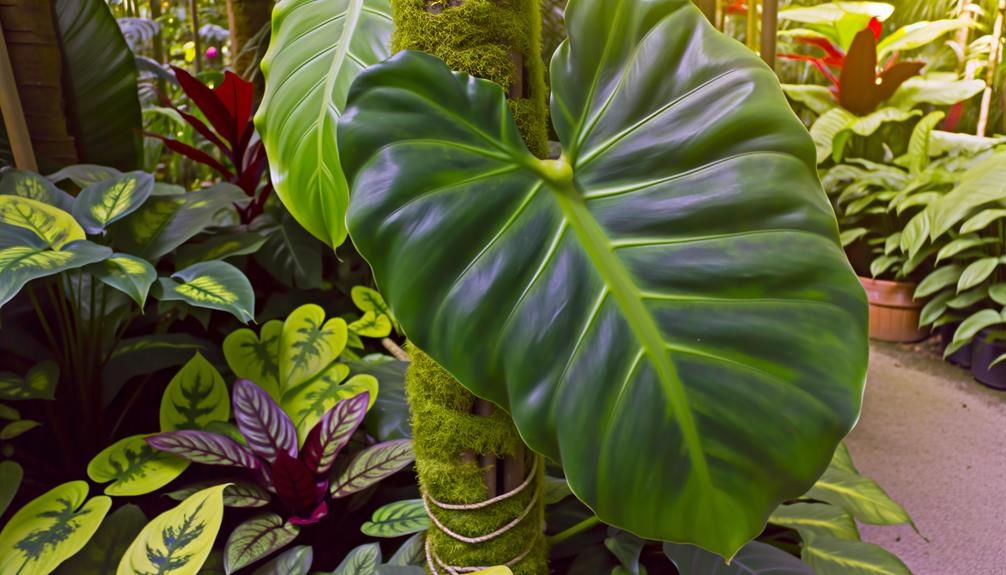
When fully mature, Philodendron verrucosum typically reaches a height of 3 to 6 feet, with leaves spanning up to 2 feet in length. This tropical species exhibits a robust growth habit, characterized by its impressive vertical stature and expansive foliage. The leaves are heart-shaped with a velvety texture, displaying intricate venation patterns that contribute to its ornamental appeal.
Stems: Thick, semi-woody, and covered in fine, bristly trichomes.
Petiole Length: Extends up to 18 inches, sturdy and often mottled with reddish hues.
Leaf Surface: Glossy upper surface with a pronounced midrib and prominent, contrasting veins.
These features collectively enhance the plant's visual impact, making it a striking addition to any botanical collection or interior space.
Conclusion
The mature Philodendron verrucosum, with its expansive, velvety leaves adorned in striking patterns of green and burgundy, epitomizes botanical intricacy. Its robust stems, bristling with fine hairs, support a sprawling growth habit, while a network of fibrous roots anchors it firmly.
This plant, reaching substantial dimensions, exemplifies nature's artistry in foliage form and texture. Through its majestic presence, the Philodendron verrucosum transforms any space into a lush, verdant sanctuary, a proof of the marvels of plant morphology.


